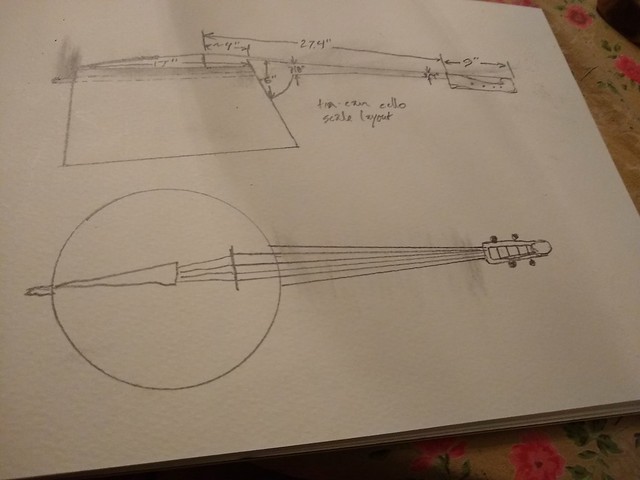posted afternoon of Sunday, August 12th, 2018
➳ More posts about The Tin-can Cello
➳ More posts about Projects
➳ More posts about Luthery
➳ More posts about Woodworking

*Actually I think 6" of width is overkill. The dowel should be ¾"wide top to bottom. sin(5°) x 20" is just under 1 ¾". If I set the top of the dowel 1 ½" from the top of the fingerboard, the bottom of the dowel at the far end will be 4" away from the top of the board. A width of 4" will be sufficient, maybe 4 ½".
posted evening of August 12th, 2018 by Jeremy Osner

(scribble scribble scribble) Oh wait, I may need more of a drop than 1 ½" between the fingerboard and the dowel. I was trying to figure out why the bridge was so much higher than the strings; it's because I'm using the layout of a cello neck. But a cello neck hits the body a foot and a bit before the end of the fingerboard, whereas my neck hits the body just past the end of the fingerboard. So I need to have a good deal more vertical offset from the soundboard. Probably back to 6" of width...
posted evening of August 12th, 2018 by Jeremy Osner

(scribble scribble scribble trig scribble) 3" of offset should do the trick. So the bottom of the dowel at the far end will be 5 ½" away from the top of the fingerboard. (Using a final bridge height of 3 ¾" or a bit more in my calculations, which seems like it should work.)
posted evening of August 12th, 2018 by Jeremy Osner

Further rethinking: I will be able to use a good deal less wide maple board, if I make the dowel parallel to the board and put the angle on the fingerboard. This is what I'm going to do. I think 4" width will work and will be much easier going with my bandsaw.
posted morning of August 13th, 2018 by Jeremy Osner

#Redesign: the portion of the neck that is glued to the fingerboard only needs to extend the length of a regular cello neck. The portion below this can be separated from the neck, and should be inline with the dowel. This will be much less bulky and more playable.
posted morning of August 13th, 2018 by Jeremy Osner

...And I can use 6/4 thick maple blank, and the heel will have much less area that needs truing. The trigonometry gets a little complex...
posted morning of August 13th, 2018 by Jeremy Osner

(stay tuned for a revised scale drawing/dimensions post...)
posted afternoon of August 13th, 2018 by Jeremy Osner










